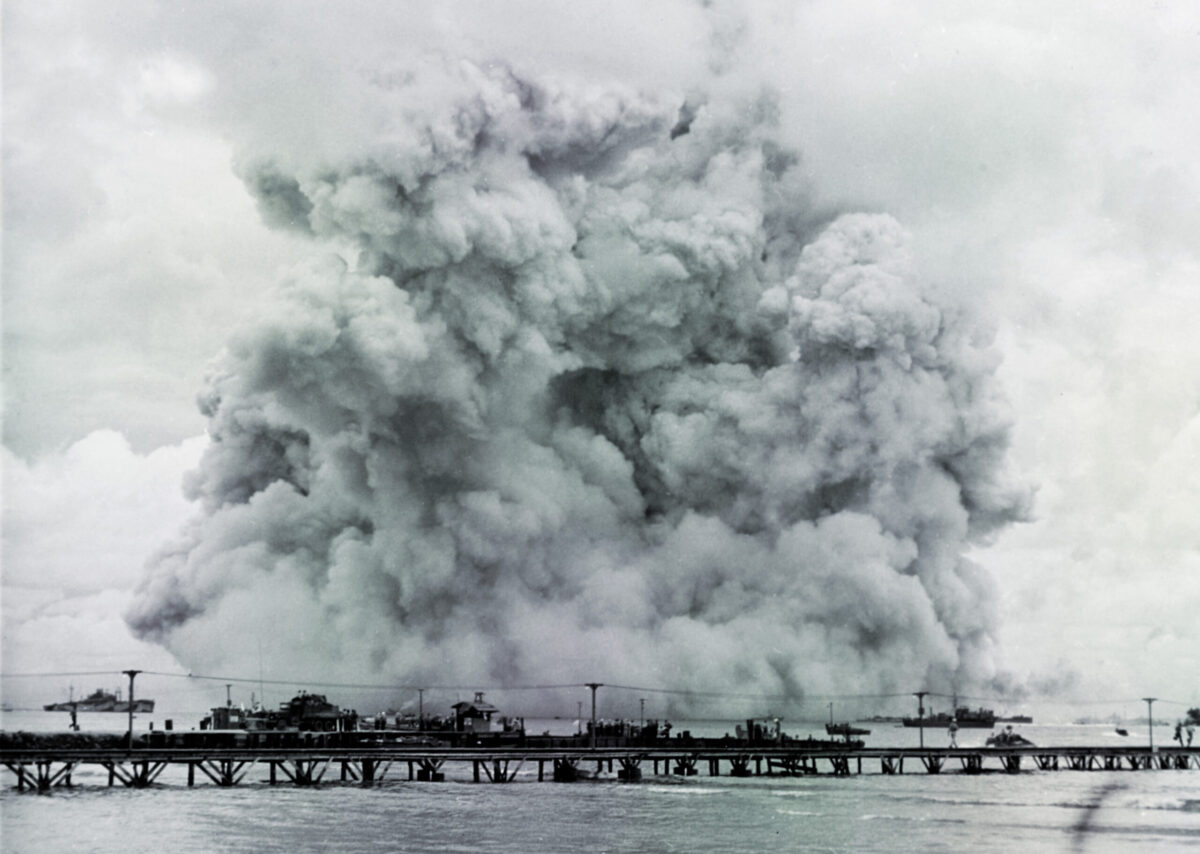The motor launch tied up at the small-boat pier in Seeadler Harbor in New Guinea to disembark a dozen men from the ammunition carrier USS Mount Hood. The date was November 10, 1944. Led by the ship’s communications officer, Lieutenant Lester Hull Wallace, the group had several errands to run on shore before returning to the ship. Wallace planned to take a couple of men with him to the fleet post office to pick up mail. Others were headed to headquarters to obtain charts and manuals. Two had dental appointments and two were on their way to the brig. The sailors were just splitting up when a tremendous blast knocked them off their feet. When they looked out into the harbor, they were stunned to realize that their ship was being wracked by explosion after explosion.
Seeadler Harbor was off the northeast coast of Manus Island, 250 miles north of mainland New Guinea. It was one of the finest anchorages in the Southwest Pacific Theater, measuring 15 miles long and four wide, with ample depth for capital ships. The army had taken the island from the Japanese in early March 1944 and within days U.S. Navy Seabees had begun to build a major advanced operating base capable of supplying and repairing the ships of Admiral William F. Halsey’s Third Fleet as it supported General Douglas MacArthur’s leap-frogging drive along New Guinea’s north coast to retake the Philippines. That same month a survey ship marked out more than 600 moorage sites throughout the vast harbor. The Manus base grew over the summer and became dotted with hundreds of buildings—mostly Quonset huts used as barracks for thousands of sailors and as warehouses for the vast amounts of materiel necessary to carry on the war.
On the morning of Friday, November 10, Mount Hood was one of some 200-odd ships in the harbor. The vessels ran the gamut from patrol boats to escort carriers and also included landing ships, tanks (LSTs), destroyers, and civilian-crewed freighters. Mount Hood was anchored at berth 380, near the harbor’s center, four miles from the entrance and 2½ miles from land. It was the first of eight AE class ammunition ships that had been converted for the U.S. Navy, with a length of 460 feet, a displacement of 14,000 tons, and a cargo capacity of 7,800 tons. Mount Hood’s keel was laid down in September 1943 and it began service as a cargo vessel named the SS Marco Polo. Once the navy took over, it converted the ship into an ammunition carrier. Commissioned in July 1944, the vessel was renamed after the dormant volcano that provides Oregon with its highest point. Its captain was Commander Harold A. Turner.
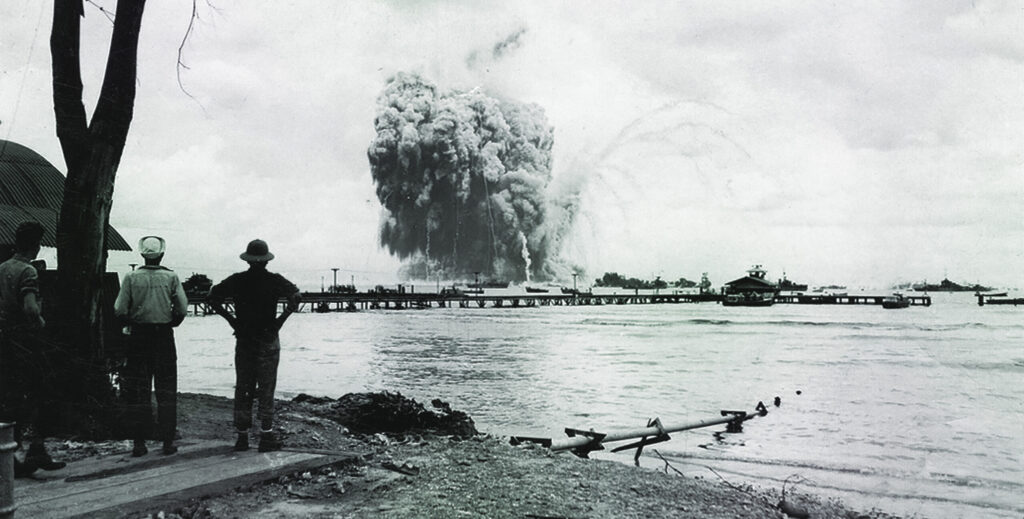
Turner struggled to find qualified seamen for his crew and many of those he received were raw recruits with no experience at sea. After an unusually short fitting out and a shakedown cruise in the Chesapeake Bay, Mount Hood stopped at Norfolk, Virginia, to load 5,000 tons of explosives and ammunition. On August 5, 1944, with its hold filled, Mount Hood departed Norfolk bound for the Admiralty Islands via the Panama Canal. The ship reached its final destination, Seeadler Harbor, on September 22. Its mission was two-fold: to dispense its cargo to other warships, and to take on any unused munitions from homeward-bound vessels.
On November 10 Mount Hood was ringed by nine landing ship, mechanized (LCM) boats and was the center of a humming hive of loading and unloading activity. The small-engine repair ship USS Mindanao was anchored off the ship’s port side just 350 yards away. USS Argonne, another repair ship that also served as the task force commander’s flagship, was 1,100 yards off.
Wallace and his going-ashore party piled aboard the captain’s 40-foot gig and at 8:25 a.m. they shoved off toward the beach. As he headed toward shore Wallace noted that aerial depth charges were being loaded aboard the Mount Hood from the landing craft moored alongside.
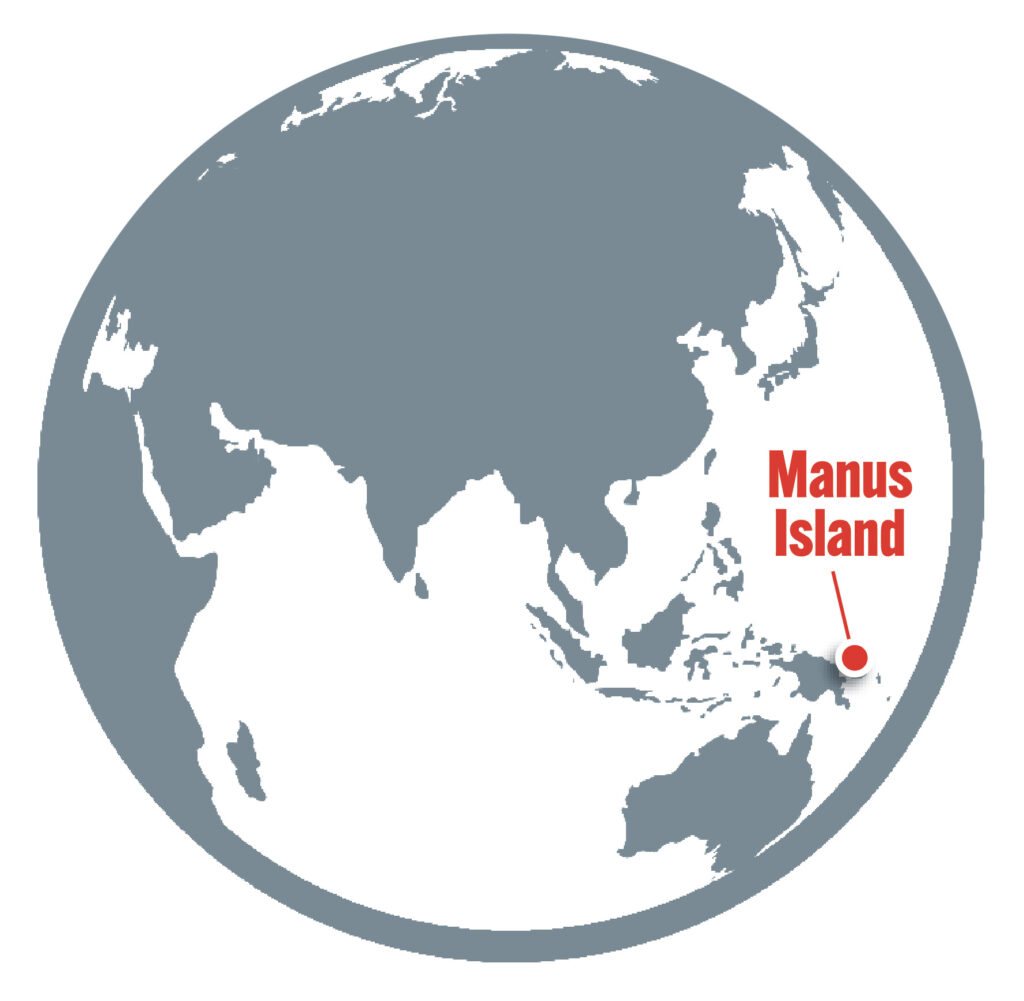
A lanky, bespectacled 29-year-old native of Georgia, Wallace had graduated from Atlanta Tech High School and earned his law degree from George Washington University in Washington, D.C., in 1941. Afterward he married Mildred Virginia French and went straight into the service of the Bureau of Internal Revenue, working in the estate and gift tax branch—but not before registering as an officer in the Naval Reserve. In 1942 the navy called him up and assigned him a place in the Bureau of Naval Personnel. After a year there the navy sent Wallace to its communications school at Harvard University, and then to the Sub Chaser Training Center at Miami, Florida. In the summer of 1944 the lieutenant was transferred to USS Mount Hood—his first at-sea deployment. He put his Ivy League training to good use when setting up the ship’s communications department.
Wallace and his crew landed at the pier and disembarked to carry out their various chores. Just as they were separating, one of the sailors loudly exclaimed, “Look!” The boat crew turned to see an eruption of smoke and fire rising above Mount Hood. In seconds a powerful explosive concussion threw them to the ground. It took a full 12 seconds for the horrible sound of the exploding ship to reach them. Even from two miles away they could see dark shapes being ejected from the explosion and curving high into the sky. The lieutenant reacted immediately. “Back to the boat!” he yelled. He told the coxswain to make all speed to return to the scene. It took more than a quarter of an hour for the motor launch to reach berth 380. They found no ship, no bodies. “There was nothing but debris all around,” Wallace later wrote. Mount Hood and her crew of 350 had simply vanished.
Wallace directed the boat to the nearest vessel, the Mindanao. He was shocked by what he saw—the port side had been pummeled by flying steel that punched 33 irregularly shaped holes into the hull, some as large as three by four feet. He later learned that everyone on the port deck—26 sailors—had been killed instantly by the blast. In all, 82 men died on Mindanao. There seemed nothing more Wallace and his men could do, so the lieutenant had the launch head back to the pier to await further orders. There he was told to stick around and that he’d be required as a witness for an about-to-be-convened official board of inquiry. He did not know then that he was the only surviving officer from Mount Hood.
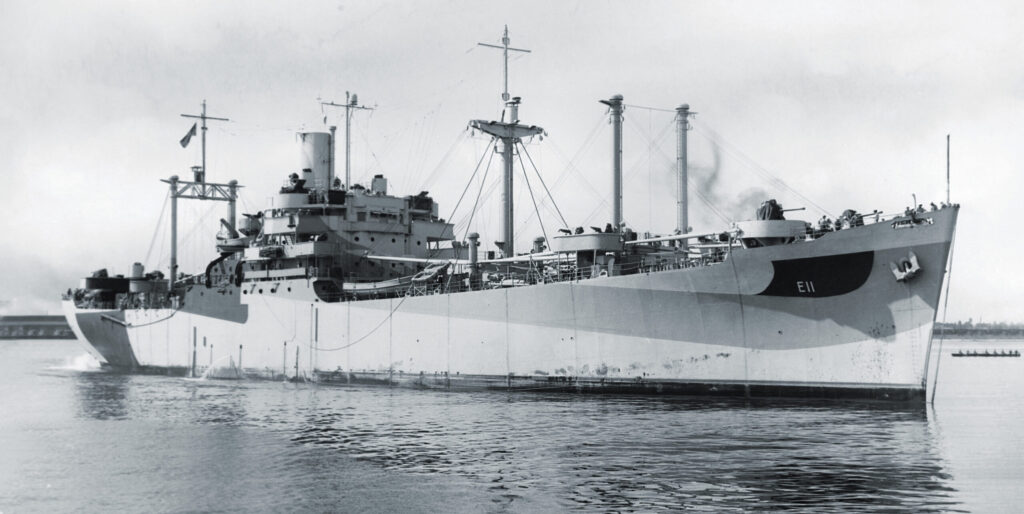
Out in the harbor ships were assessing the damage from the explosion. After the sky ceased raining metal fragments, the crew of the Argonne counted 221 pieces of the Mount Hood strewn across the deck. Said the ship’s captain, Commander T.H. Escott, “By the time we had recovered from the force of the explosion, Mount Hood was completely shrouded in a pall of dense black smoke. It was not possible to see anything worth reporting.”
Ships as far as 2,200 yards distant sustained various degrees of damage, among them the escort carriers USS Petrof Bay and Saginaw Bay, the destroyer USS Young, four destroyer escorts, and several cargo and repair vessels. Small boats like landing craft took the brunt of the blast. Many were sunk and more were damaged beyond repair. Many crewmen died. Fortunately, there were no major combat ships in the harbor that morning.
When divers entered the harbor waters to inspect Mount Hood’s wreckage, they found none to speak of—only a few stray pieces of the hull, nothing bigger than 16 by 10 feet. They were astonished to see a trench in the sand 50 feet wide and 300 feet long that the explosion had excavated to a depth of 40 feet. USS Mount Hood had literally ceased to exist.
Within days the navy organized a board of investigation to discover the cause of a catastrophe that killed 432 men and wounded an additional 371 from surrounding ships. The members, headed by a captain and two commanders, were to review all the facts, study images taken at the scene, and interview personnel who, in some way, witnessed the events of November 10, 1944. The hearings took place aboard the destroyer tender USS Sierra.
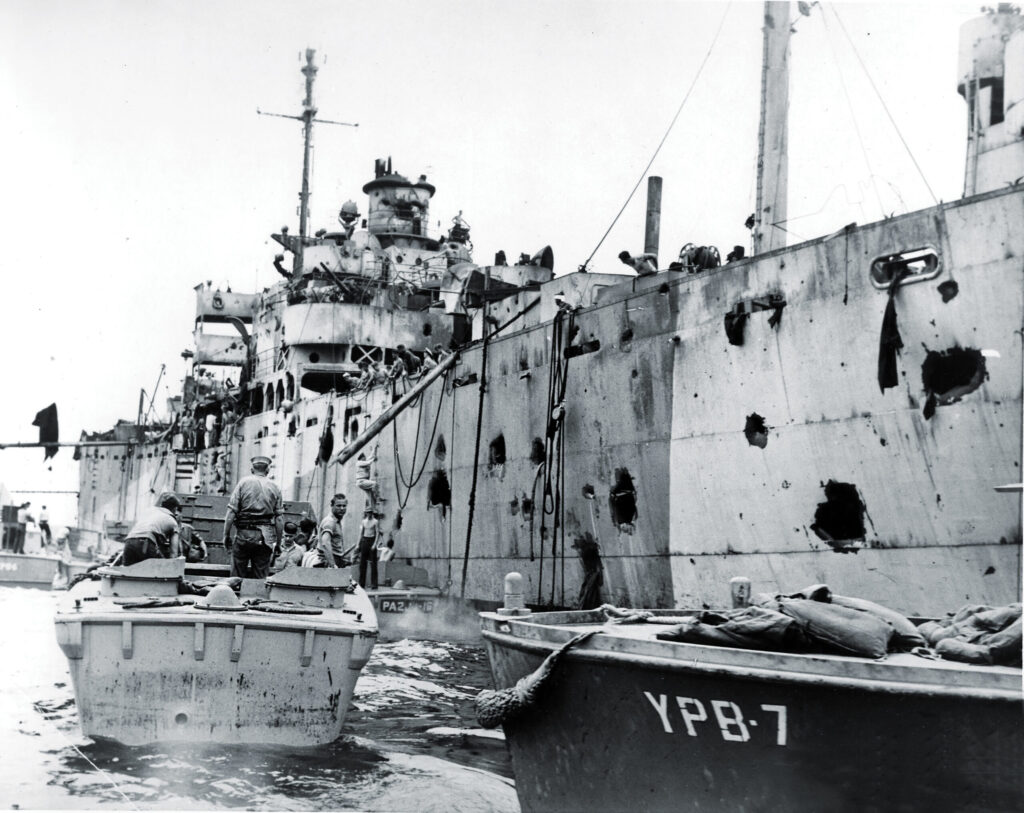
The first order of business was to define the scene at Seeadler Harbor and the role Mount Hood had played in activities there. It was noted that the ship was “the primary source for the issue of all types of ammunition,” and was taking on munitions from homebound vessels. The board noted that the harbor had four delineated anchorages for ammunition ships in the harbor’s western portion. But they were not used. After shifting the ship’s allocated place twice, the harbormaster settled it into berth 380, in the generally placid waters at the harbor’s center. That central location was more convenient for the landing craft and lighters that had to carry the ammunition back and forth. The ship was anchored in about 120 feet. At the time of the explosion Mount Hood was carrying about 3,800 tons of high explosives, including “quite a bit of damaged ammunition,” Lieutenant Wallace told the board. “Some of it was corroded and I myself remember seeing some pyrotechnics with dates as far back as 1915.”
Seaman First Class Lawrence Gaschler told the board that he should have been aboard Mount Hood that morning unloading side-by-side with his fellow crewmates from the amphibious boat pool. But he had been chosen to pilot a boat that carried an officer from the escort carrier USS Ommaney Bay to another ship in the harbor. “In my mind, we’d just passed the Hood when it blew up,” he testified. “There was this bright flash and I could feel the heat, then just a second later the concussion hit us. It knocked the officer down and knocked me out. When I came to, debris was falling in the water around.”
Motor Machinist’s Mate Lew Cowden was aboard the destroyer escort USS Whitehurst. He recalled that “we were headed toward the open sea when it exploded. They tell me we were much closer when taking on supplies and went right past [Mount Hood] on our way out. I had just started up the ladder to the fantail when the blast pushed me back. I ran forward and came up on deck amidships. The air was full of smoke and fine dust. I was told that we were far enough away to avoid damage from the blast and yet near enough that major debris blew over us.”
Not all eyewitness testimony was credible. Aviation ordnanceman Edward L. Ponichtera, who was working on the beach near the Mount Hood, asserted that he saw a twin-engine Japanese bomber drop two bombs—“each a direct hit”—on the ship. “I clearly observed the Rising Sun painted on the plane,” he said. Carl Hughes, a sailor on the Liberty ship SS William H. McGuffey, averred that he saw an enemy midget submarine broach the water near Mount Hood and fire two torpedoes.
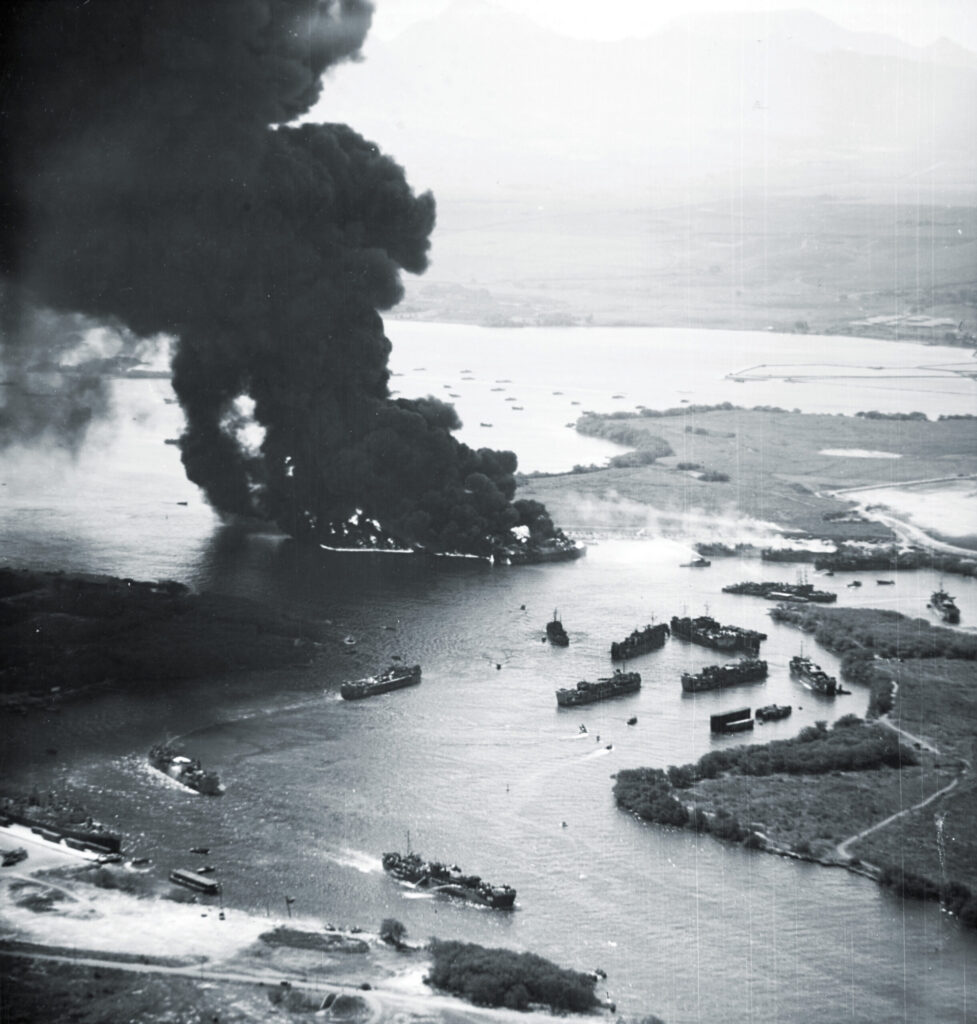
With help from the Mount Hood survivors on Wallace’s boat, the board’s investigators pieced together an accounting of the types of cargo aboard at the time of the explosion. Munitions included .30-caliber machine gun rounds, 14-inch shells for battleships, and everything in-between. There were dozens of 100-pound bombs stored away in the holds, or in the case of the 1,000-pound blockbusters, kept in a small shack on the main deck. Hold #5 contained rocket bodies and rocket motors, most of them damaged. The total was nearly 4,000 tons of munitions.
The investigators then moved over to assess Mount Hood’s crew and their role in the inferno. They felt the sailors had an overall “lack of experience” and, perhaps even more crucial, a “lack of leadership among the twenty-two officers,” which led to poor discipline onboard. “This was reflected in the rough and careless handling of ammunition,” the board noted.
In all, 133 witnesses gave testimony, supported by dozens of exhibits. Wallace was twice called to give evidence. It took the board a month to gather all of its evidence.
On December 14, 1944, the board issued its findings. “The following unsafe conditions and practices were revealed in the investigation: ammunition was being roughly handled in all parts of the ship; boosters, fuzes and detonators were stowed together in one hold in a manner contrary to regulations governing transportation of military explosives; safety regulations for handling ammunition were not posted in conspicuous places and there was a general lack of instruction to the crew in safety measures; there was a lack of enforcing the prohibitions of smoking; there was evidence that ammunition was accepted on board which was definitely defective and should have been destroyed by dumping in deep water.”
The board’s final conclusion was that “The explosion was caused by a force or agency within the USS Mount Hood itself.” Had Captain Turner survived he and his senior officers would have been held responsible. The board had to admit that they had no clear idea of the exact cause of the disaster—they could only guess—which was frustrating for the three members.
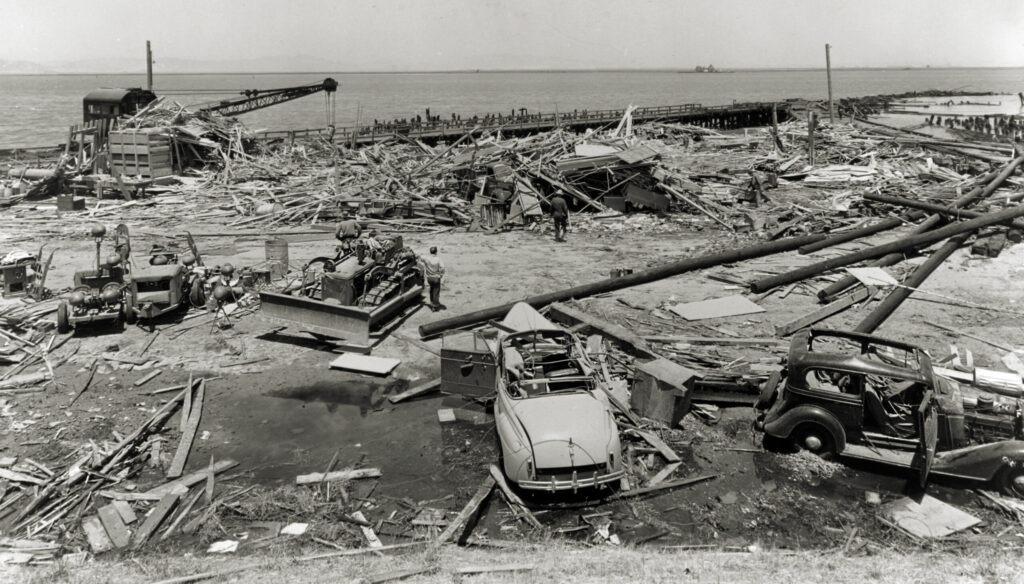
Regarding the statements about a Japanese bomber or midget submarine, the board firmly stated there was no evidence that either of these attacks took place, and so discounted the accounts.
In his endorsement of the report, Admiral Chester W. Nimitz, Commander of Pacific Ocean Areas and Commander of the U.S. Pacific Fleet, wrote, “The question of negligence is not involved but rather that the technical mistakes made by the above named officers [Turner and others] were errors in judgement resulting from a keen desire to meet necessary military commitments and move on with the progress of the war.” The admiral noted, “The exigencies of war will always require the acceptance of certain operational hazards.”
While working on its conclusions the board took note of two other incidents involving explosions on ammunition-carrying vessels, one in May 1944 and the other in July.
On May 21 an LST tied up at Pearl Harbor’s West Loch was loading mortar rounds for the upcoming invasion of the Mariana Islands when it was blown up after an errant shell fell into a stack of munitions in the hold. The resulting conflagration quickly spread to other nearby LSTs. Six of the craft were sunk and 160 men killed.
And on July 17 a blast at the naval magazine ammunition loading facility in Port Chicago, California, flipped and sank the freighter SS Quinault Victory and vaporized the Liberty ship SS E.A. Bryan. Three-hundred-twenty men died, two-thirds of them African American stevedores. Both ships were tied up at a finger pier loading ammunition from a string of railway boxcars. The official finding of facts produced by the board of inquiry noted that “no intent, fault, negligence, or inefficiency of any person in the naval service caused the explosions.” Among shortcomings that led to the disaster, the board wrote, “The officers had little stevedoring experience, none with handling enlisted personnel, and none with explosives.” They went on to describe the situation with the enlisted men, and the racism in the conclusions was only thinly veiled: “They were unreliable, and lacked capacity to understand instructions.” (When loading was ordered to resume weeks later, many of the sailors involved refused, leading to a mass court-martial. Those convicted of mutiny and sentenced to hard labor became known as the Port Chicago 50 and gained their release after the war and only following a public outcry.)
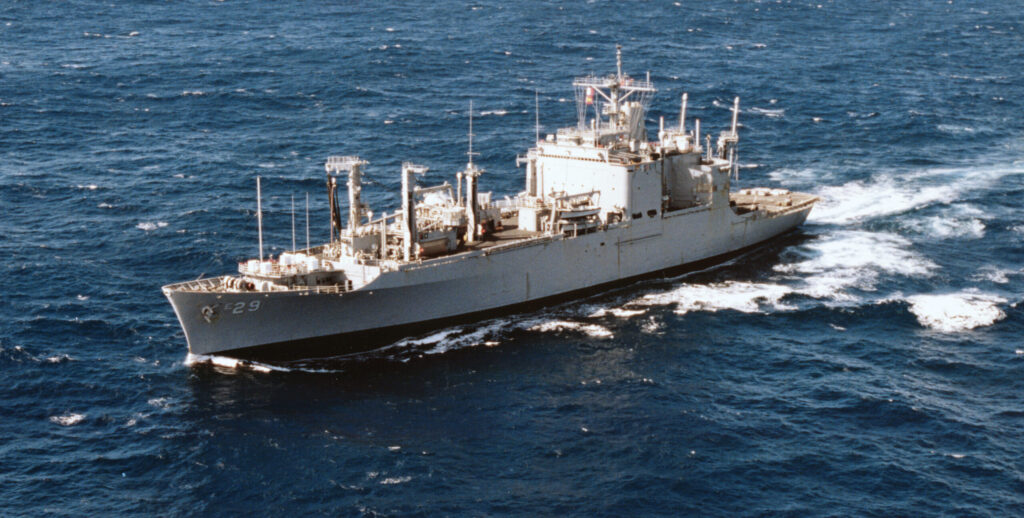
So, in the space of seven months three eerily similar accidents wreaked havoc on the navy’s explosives supply lines. Nine ships were lost and more than 900 men died.
In March 1945 the navy’s Bureau of Ordnance issued a “circular” letter to relevant commands that emphasized how easy it was to explode “bomb type” ammunition accidentally “by impacts not severe enough to cause even slight rupture to container walls. Any idea that hazards due to ‘mere denting’ of containers must be thoroughly dispelled.” The letter went on to outline a series of revised loading practices intended to cut down on the risks of explosions, in particular how dangerous materials should be handled. After tightening up the rules the navy suffered no further cataclysms.
Following his testimony to the board of investigation, Lieutenant Wallace returned to Arlington, Virginia, to reunite with his wife and son. For his next tour the navy sent him for duty in the communications unit of a carrier—exactly what he had sought all along. He spent the next ten months on station in the Pacific Theater, where he was promoted to commander. Wallace was discharged in late 1945 and when he returned home, he reclaimed his old post at the Bureau of Revenue (later renamed the Internal Revenue Service). He retired in 1974 and died in 2012 at the age of 97.
Mount Hood was not forgotten. In July 1968 a second ship named for the Oregon volcano was launched at Sparrows Point, Maryland. Designated AE-29, it was the fourth Kilauea-class ammunition ship to enter navy service. The second Mount Hood served in Vietnam in 1972, earning a campaign star, and served in the Gulf War in 1991. The ship was decommissioned in August 1999 and was sold for scrap in September 2013.

